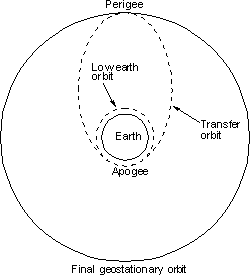Methods used to place a satellite into orbit
There is a considerable amount of expertise and technology
used to ensure that satellites enter their orbits in the most energy efficient
ways possible. This ensures that the amount of fuel required is kept to a
minimum; an important factor on its own because the fuel itself has to be
transported until it is used. If too much fuel has to be used then this
increases the size of the launch rocket and in turn this greatly increases the
costs.
Many satellites are placed into geostationary orbit, and one
common method of achieving this is based on the Hohmann transfer principle. This
is the method use when the Shuttle launches satellites into orbit. Using this
system the satellite is placed into a low earth orbit with an altitude of around
180 miles. Once in the correct position in this orbit rockets are fired to put
the satellite into an elliptical orbit with the perigee at the low earth orbit
and the apogee at the geostationary orbit as shown. When the satellite reaches
the final altitude the rocket or booster is again fired to retain it in the
geostationary orbit with the correct velocity.

Use of a transfer orbit to place a satellite in
geostationary orbit
Alternatively when launch vehicles like Ariane are used the
satellite is launched directly into the elliptical transfer orbit. Again when
the satellite is at the required altitude the rockets are fired to transfer it
into the required orbit with the correct velocity.
These are the two main methods of placing satellites into
orbit. Naturally it would be possible to place a satellite directly into
geostationary orbit, but this would take more energy and would not be feasible.

Delta Rocket Launching Mars Pathfinder 19 Sep 2003
Image courtesy Nasa
|